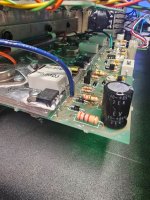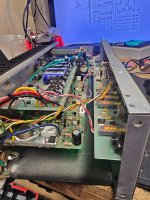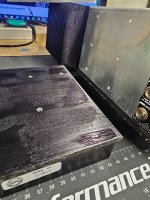Hi all, I have this GK 800RB on the bench today that blows fuses on startup. This unit was worked on by a previous tech and had some transistors replaced but thats all I know. I tried powering it up with the power disconnected from the preamp board but the power amp board is soldered so I haven't tried disconnecting that yet.
How should I go about diagnosing the issue? I am running out of fuses lol.

How should I go about diagnosing the issue? I am running out of fuses lol.
Attachments
Blowing fuses wont fix it for sure.
Taking on somebodys elses work is usually that.
Whatever they touched the problem is usually there.
Then after that you figure out the original problem.
FUN !
Then you fix there problem and original problem.
Diode check all semiconductors see if any are toasted.
And test all resistors for value drift / open
Look for bad traces.
Make sure the transistors are not shorted to the case/ heatsink
VI limiters and diodes might have been blasted from original fault.
Remove power amp power. Check if pre works etc etc.
Basic trouble shooting. It is internet we are left to wild guessing.
GK usually rail jumper, class G
check zeners and transistors for second rail control.
remove transformer secondary connections check first / second rail voltages on transformer.
Taking on somebodys elses work is usually that.
Whatever they touched the problem is usually there.
Then after that you figure out the original problem.
FUN !
Then you fix there problem and original problem.
Diode check all semiconductors see if any are toasted.
And test all resistors for value drift / open
Look for bad traces.
Make sure the transistors are not shorted to the case/ heatsink
VI limiters and diodes might have been blasted from original fault.
Remove power amp power. Check if pre works etc etc.
Basic trouble shooting. It is internet we are left to wild guessing.
GK usually rail jumper, class G
check zeners and transistors for second rail control.
remove transformer secondary connections check first / second rail voltages on transformer.
Last edited:
Ok I got the board out, running some tests now.
Has anyone ever seen clear thermal grease? Whatever this heatsink was applied with is clear. I thought it was condensation and got my hand all greasy.
When I reinstall, should I use real thermal paste?
Has anyone ever seen clear thermal grease? Whatever this heatsink was applied with is clear. I thought it was condensation and got my hand all greasy.
When I reinstall, should I use real thermal paste?
Attachments
Uh, yeah, the heat sink compound I buy is white. The white stuff is the heat conductive part. Dow 340 is the compound I buy.
Back to basics. Powering up suspicious amps, AC goes through a tungsten bulb current limiter. 60 W bulb is what we use in the Westinghouse electric part of the world, For small power. My light bulb is in a grounded metal box under a perforated cover, with a circuit breaker on input. In case the feed wire comes off the edison base and flies around hitting the metal box.
Light comes on, stays lit, big problem. No fuses blown. Connect DVM black probe to speaker ground with alligator clip. Use one hand on red probe with power on, looking for shorted parts with volts scale. Never use 2 hands with power on. Never wear jewelry/metal on hands, wrists, or neck. Wear safety glasses, parts explode and solder splashes especially when coming off.
Back to basics. Powering up suspicious amps, AC goes through a tungsten bulb current limiter. 60 W bulb is what we use in the Westinghouse electric part of the world, For small power. My light bulb is in a grounded metal box under a perforated cover, with a circuit breaker on input. In case the feed wire comes off the edison base and flies around hitting the metal box.
Light comes on, stays lit, big problem. No fuses blown. Connect DVM black probe to speaker ground with alligator clip. Use one hand on red probe with power on, looking for shorted parts with volts scale. Never use 2 hands with power on. Never wear jewelry/metal on hands, wrists, or neck. Wear safety glasses, parts explode and solder splashes especially when coming off.
Last edited:
Thank you for the advice indianajo
The -85v and +85v lines are reading -75v and +75v, would this cause an issue with the power amp?
I have replaced 2 blown diodes (D10 and D12) as well as repaired a broken trace. I would like to test all the transistors but i think I am not getting accurate readings having them in circuit so I am just going to put it back together and test the amp.
The -85v and +85v lines are reading -75v and +75v, would this cause an issue with the power amp?
I have replaced 2 blown diodes (D10 and D12) as well as repaired a broken trace. I would like to test all the transistors but i think I am not getting accurate readings having them in circuit so I am just going to put it back together and test the amp.
In amplification area, look for Vbe +-0.6 v. Lamp drivers and relay drivers can be off when not used. Look for Vce +-1 v or higher. The stack from + to - rails should decrease symmetrically on the two sides. Dim bulb tester will make the voltages less, but this amp does not have any IC's requiring +-15 v rail voltages. Sometimes in late 80's 90's amps the DBT makes the front end op amps not work because the power supplies do not activate the regulator IC or zener.
Watch the tip of the probe and do not short anything to anything else. I like Pamona grabbers for probing, shorter. Some people put 1/16" heat shrink over most of the DVM probe except the tip. Leave black of DVM connected to speaker ground or middle of rail caps. Probe with one hand and write down the numbers, then subtract to find Vbe and Vce.
Watch the tip of the probe and do not short anything to anything else. I like Pamona grabbers for probing, shorter. Some people put 1/16" heat shrink over most of the DVM probe except the tip. Leave black of DVM connected to speaker ground or middle of rail caps. Probe with one hand and write down the numbers, then subtract to find Vbe and Vce.
- Home
- Amplifiers
- Solid State
- GK amp blows fuses on startup


